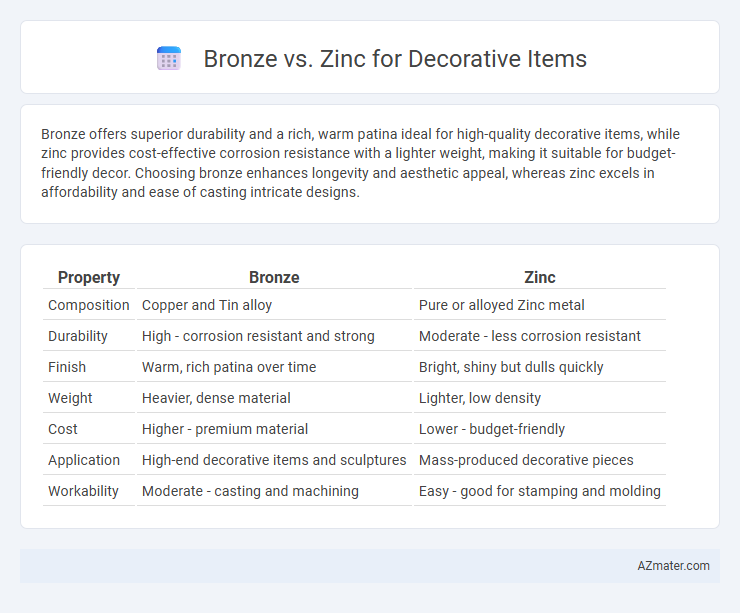Bronze offers superior durability and a rich, warm patina ideal for high-quality decorative items, while zinc provides cost-effective corrosion resistance with a lighter weight, making it suitable for budget-friendly decor. Choosing bronze enhances longevity and aesthetic appeal, whereas zinc excels in affordability and ease of casting intricate designs.
Table of Comparison
| Property | Bronze | Zinc |
|---|---|---|
| Composition | Copper and Tin alloy | Pure or alloyed Zinc metal |
| Durability | High - corrosion resistant and strong | Moderate - less corrosion resistant |
| Finish | Warm, rich patina over time | Bright, shiny but dulls quickly |
| Weight | Heavier, dense material | Lighter, low density |
| Cost | Higher - premium material | Lower - budget-friendly |
| Application | High-end decorative items and sculptures | Mass-produced decorative pieces |
| Workability | Moderate - casting and machining | Easy - good for stamping and molding |
Introduction to Bronze and Zinc in Decorative Arts
Bronze, an alloy primarily of copper and tin, has been revered in decorative arts for its durability, warm hue, and ability to capture intricate details in sculptures and ornaments. Zinc, known for its bluish-silver appearance and resistance to corrosion, is often used in castings, moldings, and decorative hardware due to its lightweight and cost-effectiveness. Both metals offer distinct aesthetic qualities and functional advantages, making them popular choices in modern and traditional decorative items.
Historical Use of Bronze and Zinc in Decoration
Bronze has been historically favored in decorative items for its durability and warm, golden-brown patina that develops over time, dating back to ancient civilizations such as the Greeks and Romans. Zinc, introduced later, gained popularity in the 19th century due to its affordability and resistance to corrosion, often used in architectural ornaments and garden decorations. The enduring legacy of bronze reflects its association with classical art and sculpture, while zinc's versatility supports more contemporary decorative applications.
Material Composition: Bronze vs Zinc
Bronze is primarily composed of copper and tin, offering a durable and corrosion-resistant alloy ideal for decorative items with a warm, rich patina that enhances over time. Zinc, often alloyed with small amounts of aluminum, copper, or magnesium, is lighter and less expensive but more prone to corrosion and wear under prolonged exposure. The choice between bronze and zinc depends on the desired longevity, aesthetic appeal, and budget of the decorative item.
Appearance and Aesthetic Qualities
Bronze offers a warm, classic appearance with a rich, reddish-brown patina that evolves over time, creating a timeless, elegant aesthetic ideal for traditional decorative items. Zinc presents a cooler, silvery-gray tone that can develop a subtle matte finish, lending modern and industrial charm to contemporary designs. Both metals provide distinct visual qualities that enhance decorative pieces through unique color variations and textures.
Durability and Longevity Comparison
Bronze exhibits superior durability and longevity compared to zinc, owing to its higher resistance to corrosion and wear in outdoor environments. Bronze's copper and tin alloy composition ensures a sturdier structure that withstands weathering and aging over decades without significant degradation. Zinc, while more affordable and lightweight, tends to oxidize and lose its finish faster, making bronze the preferred choice for long-lasting decorative items.
Workability and Design Versatility
Bronze offers superior workability due to its excellent malleability and ability to capture fine details, making it ideal for intricate decorative items. Zinc, while less malleable, allows for versatile casting and shaping through processes like die casting, enabling cost-effective production of varied designs. The choice between bronze and zinc for decorative items ultimately depends on the desired level of detail and budget considerations.
Resistance to Corrosion and Tarnishing
Bronze exhibits superior resistance to corrosion and tarnishing compared to zinc due to its copper content, which forms a protective patina over time, enhancing durability in outdoor environments. Zinc, while initially shiny and cost-effective, is more susceptible to corrosion, especially when exposed to moisture and acidic conditions, leading to quicker surface degradation. Choosing bronze ensures longer-lasting aesthetic appeal and structural integrity for decorative items exposed to varying weather conditions.
Maintenance and Care Requirements
Bronze decorative items develop a natural patina over time that requires minimal maintenance, only occasional polishing with a non-abrasive cloth to preserve their warm, antique appearance. Zinc items resist corrosion and tarnish but benefit from regular cleaning with mild soap and water to avoid buildup of grime and maintain their smooth, shiny finish. Both metals should be kept dry and away from harsh chemicals to extend their lifespan and aesthetic appeal.
Cost and Availability Factors
Bronze, an alloy primarily of copper and tin, generally costs more than zinc due to its higher metal content and complex production process, making it less budget-friendly for large decorative items. Zinc, abundant and easier to extract, offers superior availability and lower costs, making it a preferred choice for mass-produced decorative pieces. The cost-effectiveness and widespread supply of zinc enable greater scalability, while bronze's higher cost often aligns with premium or artisanal decorative items.
Choosing the Right Metal for Your Decorative Item
Bronze offers superior durability and a warm, timeless patina that enhances decorative items, making it ideal for outdoor sculptures and heirloom pieces. Zinc provides excellent corrosion resistance with a lighter weight and more affordable cost, suitable for intricate designs and indoor decor. Selecting the right metal depends on factors such as environmental exposure, desired aesthetic, and budget constraints for your decorative item.

Infographic: Bronze vs Zinc for Decorative Item
 azmater.com
azmater.com